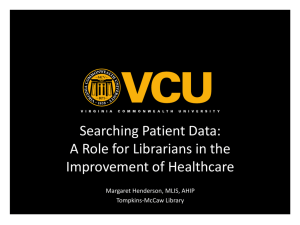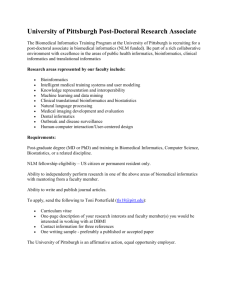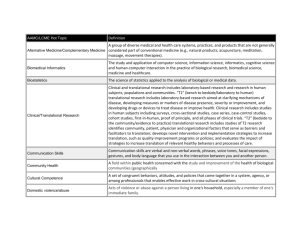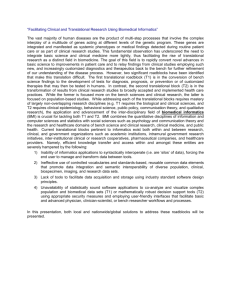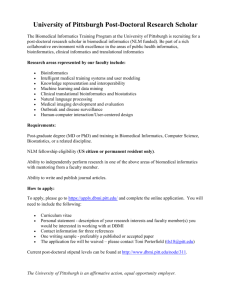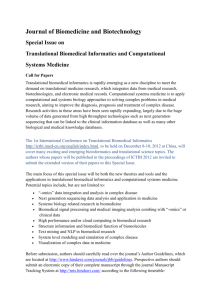downloading
advertisement
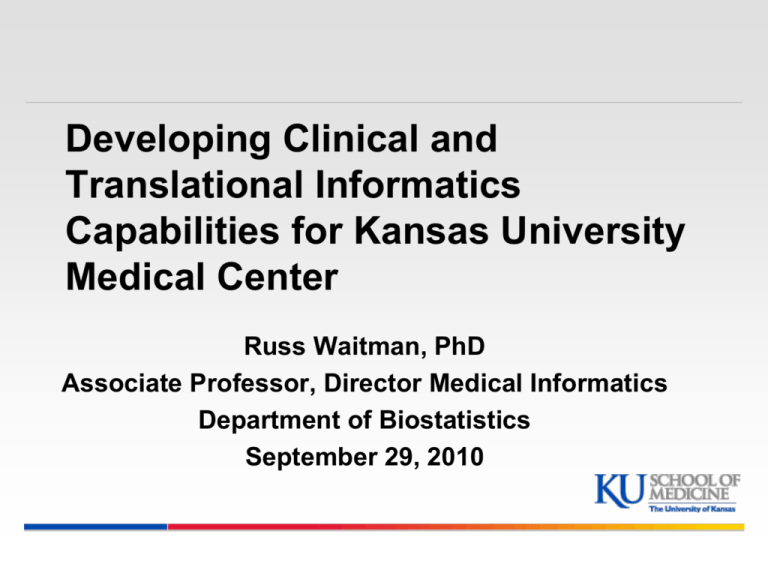
Developing Clinical and Translational Informatics Capabilities for Kansas University Medical Center Russ Waitman, PhD Associate Professor, Director Medical Informatics Department of Biostatistics September 29, 2010 Outline What is Biomedical Informatics? What are the Clinical Translational Science Awards? Biomedical Informatics Section Specific Aims Data Management Observations Timeline i2b2 demo Questions Background: Charles Friedman The Fundamental Theorem of Biomedical Informatics: A person working with an information resource is better than that same person unassisted. NOT!! Charles P. Friedman: http://www.jamia.org/cgi/reprint/16/2/169.pdf Background: William Stead The Individual Expert Clinician Synthesis & Decision Evidence Patient Record William Stead: http://courses.mbl.edu/mi/2009/presentations_fall/SteadV1.ppt The demise of expert-based practice is inevitable Facts per Decision 1000 Proteomics and other effector molecules 100 Functional Genetics: Gene expression profiles 10 Structural Genetics: e.g. SNPs, haplotypes Human Cognitive Capacity 5 Decisions by Clinical Phenotype 1990 2000 2010 2020 William Stead: http://courses.mbl.edu/mi/2009/presentations_fall/SteadV1.ppt Background: Edward Shortliffe Biomedical Informatics Applications Basic Research Applied Research Biomedical Informatics Methods, Techniques, and Theories Bioinformatics Imaging Clinical Informatics Informatics Molecular and Tissues and Cellular Organs Processes Individuals (Patients) Public Health Informatics Populations And Society Edward Shortliffe: http://www.dentalinformatics.com/conference/conference_presentations/shortliffe.ppt Background: Edward Shortliffe Biomedical Informatics Research Areas Biomedical Knowledge Machine learning Text interpretation Knowledge engineering Knowledge Acquisition Knowledge Base Model Development Information Retrieval Diagnosis Biomedical Data Biomedical Research Planning & Data Analysis Inferencing System Treatment Planning Data Acquisition Real-time acquisition Imaging Speech/language/text Specialized input devices Data Base Human Interface Teaching Image Generation Edward Shortliffe: http://www.dentalinformatics.com/conference/conference_presentations/shortliffe.ppt Clinical and Translational Science Awards A NIH Roadmap Initiative “It is the responsibility of those of us involved in today’s biomedical research enterprise to translate the remarkable scientific innovations we are witnessing into health gains for the nation.” Background: Dan Masys NIH Goal to Reduce Barriers to Research • Administrative bottlenecks • Poor integration of translational resources • Delay in the completion of clinical studies • Difficulties in human subject recruitment • Little investment in methodologic research • Insufficient bi-directional information flow • Increasingly complex resources needed • Inadequate models of human disease • Reduced financial margins • Difficulty recruiting, training, mentoring scientists CTSA Objectives: The purpose of this initiative is to assist institutions to forge a uniquely transformative, novel, and integrative academic home for Clinical and Translational Science that has the consolidated resources to: 1) captivate, advance, and nurture a cadre of well-trained multiand inter-disciplinary investigators and research teams; 2) create an incubator for innovative research tools and information technologies; and 3) synergize multi-disciplinary and inter-disciplinary clinical and translational research and researchers to catalyze the application of new knowledge and techniques to clinical practice at the front lines of patient care. NIH CTSAs: Home for Clinical and Translational Science Clinical Research Ethics Trial Design NIH Gap! Biomedical Informatics Clinical Resources Biostatistics Advanced Degree-Granting Programs CTSA HOME Participant & Community Involvement Regulatory Support Industry Other Institutions Dan Masys: http://courses.mbl.edu/mi/2009/presentations_fall/masys.ppt Reengineering Clinical Research Interdisciplinary Research Innovator Award Bench Building Blocks and Pathways Molecular Libraries Bioinformatics Computational Biology Nanomedicine Public-Private Partnerships (IAMI) Bedside Translational Research Initiatives Practice Integrated Research Networks Clinical Research Informatics NIH Clinical Research Associates Clinical outcomes Harmonization Training Dan Masys: http://courses.mbl.edu/mi/2009/presentations_fall/masys.ppt Building a Plan: Environmental Comparison Vanderbilt versus Kansas VUMC: unified leadership across hospitals, clinics, academics Unified informatics: from network jack and server, to library and bioinformatics cores Build/buy mix legacy -> complexity Large consolidated academic home for informatics Data sharing for research a non issue KU/KUMC, Rest of the world: not so homogenous What can one do with EPIC or Cerner + added informatics? Validated solutions more likely to scale. Data sharing involves multiple organizations KUMC Opportunities Quality Focused Hospital Without every solution involving informatics Prior CTSA goal: Data “Warehouse” Advance research and clinical quality “Green Field” for newer technologies State and Region KUMC strong in community outreach research Link our data to external information? (Ex: KHPA Medicaid data) Health Information Exchange “window” KU-Lawrence Researchers, Cerner, Stowers Institute Existing Teams Clinical Research & Medical Informatics CRIS: Comprehensive Research Information System Team New Medical Informatics plus KUMC Information Resources critical contributors for infrastructure Bioinformatics K-INBRE Bioinformatics Core Center for Bioinformatics and Engineering School Dr. Gerry Lushington Center for Health Informatics World Class Telemedicine Leading Health Information Exchange for the State Terminology, Training, Simulation Expertise Dr. Judith Warren Clinical Research Information Systems KUMC has purchased Velos eResearch and calls it “CRIS” Define Studies, Assign Patients to Studies Design and Capture data on electronic Case Report Forms (CRFs) – ideally in real time. Capture Adverse Events, Reports, Export Data for analysis. Options: Samples, Financials, Regulatory IRB Other Approaches OnCore by Forte Research Systems – more expensive, highly customized for Cancer Centers…. Ferrari to Velos’ Audi. RedCap by Paul Harris at Vanderbilt University – “free but not open source”, capabilities growing. Think Hyundai CRIS Intro Screen CRIS: sample e Case Report Form CRIS: Document Adverse Events KUMC CTSA Specific Aims 1. Provide a HICTR portal for investigators to access clinical and translational research resources, track usage and outcomes, and provide informatics consultative services. 2. Create a platform, HERON (Healthcare Enterprise Repository for Ontological Narration), to integrate clinical and biomedical data for translational research. 3. Advance medical innovation by linking biological tissues to clinical phenotype and the pharmacokinetic and pharmacodynamic data generated by research cores in phase I and II clinical trials (addressing T1 translational research). 4. Leverage an active, engaged statewide telemedicine and Health Information Exchange (HIE) effort to enable community based translational research (addressing T2 translational research). Aim #1: Create a Portal and Consult Bring together existing resources Translational Technologies Resource Center Link to national resources www.vivo.org – Facebook for researchers www.eagle-i.org – National resources (rodents, RNAi, to patient registries) Develop tools to measure and track our investment Pilot funding requests, electronic Institutional Review Board process Provide a hands on informatics consult service Also organize existing resources Portal: Access + Measurement Aim #2: Create a data “fishing” platform Develop business agreements, policies, data use agreements and oversight. Implement open source NIH funded (i.e. i2b2) initiatives for accessing data. Transform data into information using the NLM UMLS Metathesaurus as our vocabulary source. Link clinical data sources to enhance their research utility. Develop business agreements, policies, data use agreements and oversight. September 6, 2010 the hospital, clinics and university signed a master data sharing agreement to create the repository. Four Uses: After signing a system access agreement, cohort identification queries and view-only access is allowed but logged and audited Requests for de-identified patient data, while not deemed human subjects research, are reviewed. Identified data requests require approval by the Institutional Review Board prior to data request review. Medical informatics will generate the data set for the investigator. Contact information from the HICTR Participant Registry have their study request and contact letters reviewed by the Participant and Clinical Interactions Resources Program Constructing a Research Repository: Ethical and Regulatory Concerns Who “owns” the data? Doctor, Clinic/Hospital, Insurer, State, Researcher… perhaps the Patient? Perception/reality is often the organization that paid for the system owns the data. My opinion: we are custodians of the data, each role has rights and responsibilities Regulatory Sources: Health Insurance Portability and Accountability Act (HIPAA) Human Subjects Research Research depends on Trust which depends on Ethical Behavior and Competence Goals: Protect Patient Privacy (preserve Anonymity), Growing Topic: Quanitifying Re-identification risk. Re-identification Risk Example Will the released columns in combination with publicly available data re-identify individuals? What if the released columns were combined with other items which “may be known”? Sensitive columns, diagnoses or very unique individuals? New measures to quantify reidentification risk. Reference: Benitez K, Malin B. Evaluating re-identification risks with respect to the HIPAA privacy rule. J Am Med Inform Assoc. 2010 Mar-Apr;17(2):169-77. Constructing a Repository: Understanding Source Systems, Example CPOE Most Clinical Systems focus on transaction processing for workflow automation WizOrder Client Repackages and Routes Internal Format HL7 Generic Interface Engine (GIE) HL7 WizOrder Server Temporary Data queue (TDQ) Orderables, Orderset DB Pharmacy System SQL document Mainframe DB2 Knowledge Base, Files SQL Laboratory System SQL Drug DB Print SubSystem SQL SQL SQL Lab DB Rx DB Constructing a Repository: Understanding Differing Data Models used by Systems Hierarchical databases (MUMPS), still very common in Clinical systems (VA VISTA, Epic, Meditech) http://www.cs.pitt.edu/~chang/156/14hier.html Murphy SN, Weber G, Mendis M, Gainer V, Chueh HC, Churchill S, Kohane I. Serving the enterprise and beyond with informatics for integrating biology and the bedside (i2b2). J Am Med Inform Assoc. 2010 Mar-Apr;17(2):124-30. http://www.ibm.com/developerworks/library/x-matters8/index.html Star Schemas: Data Warehouses Relational databases (Oracle, Access), dominant in business and clinical systems (Cerner, McKesson) HERON: Repository Architecture Workflow: System Access Workflow & Oversight: Request Data Implement NIH funded (i.e. i2b2) initiatives for accessing data. i2b2: Count Cohorts i2b2: Patient Count in Lower Left i2b2: Ask for Patient Sets i2b2: Analyze Demographics Plugin i2b2: Demographics Plugin Result i2b2: View Timeline i2b2: Timeline Results Transform data into information using standard vocabularies and ontologies Source terminology Completed planned Notes Demographics: i2b2 April 2010 Using i2b2 hierarchy. Restricted search criteria to geographic regions (> 20,000 persons) instead of individual zipcodes Diagnoses: ICD9 Procedures: CPT April 2010 June 2010 Using i2b2 hierarchy UMLS extract scripts developed with UTHSC at Houston Lab terms: LOINC Medication ontologies: NDF-RT November 2010 December 2010 Nursing Observations July 2010- Pathology: SNOMED CT February 2011 Plan to use i2b2 hierarchy Physiologic effect, mechanism of action, pharmacokinetics, and related diseases. NDNQI pressure ulcers mapped to SNOMED CT to evaluate automated extraction of self reported activity. (Drs. Dunton and Warren.) Providing coded pathology results and patient diagnosis is a critical objective for defining cancer study cohorts in Aim 3. Clinical narrative 2012 National Center for Biological Ontology 2013 As hospital restructures clinical narrative documentation to use EPIC’s SmartData (CUI) concepts, will determine appropriate standard. In support of Aim 3 focus on bridging clinical and bioinformatics to advance novel methods. Link clinical data sources to enhance their research utility. Data source Source System EPIC System “Go-Live” Date 2006 Data extraction completed planned September 2010 Inpatient/Emergency demographics, “ADT” locations & services Inpatient diagnoses (DRG, ICD9) EPIC 1990 September 2010 Outpatient visits services, diagnoses, procedures (ICD, CPT) Laboratory Results (inpatient/outpatient) IDX 2002 November 2010 EPIC 2007 November 2010 Electronic Medication Administration Inpatient inputs, outputs and discrete nursing observations Clinical Research Information System EPIC EPIC 2007 2007 December 2010 2011 CRIS 2007 2011 Provider Order Entry Problem List and Provider Notes Microbiology, Cardiology, Radiology 2010 2009 2006 2011 2011 2011 Medication reconciliation Perioperative schedule and indicators EPIC EPIC EPIC/Misys Theradoc EPIC ORSOS 2007 2005 2011 2012 Social Security Death Indicator Medicaid databases SSDI KHPA Na 2005 2012 2012 Aim #3: Link biological tissues to clinical phenotype and our research cores’ results Support Cancer Center, IAMI, and bridge to Lawrence Research First focus: Incorporate clinical pathology and biological tissue repositories with HERON and CRIS to improve cohort identification, clinical trial accrual, and improved clinical trial characterization Aligned with existing enterprise objectives to improve biological tissue repository information systems Clinical trial accrual identified by many as a weak point institutionally Target both biological research specimens and routine clinical pathology Aim #3: Link biological tissues to clinical phenotype and our research cores’ results Second focus: Support IAMI clinical trials by integrating and standardizing information between bioinformatics and pharmacokinetic/pharmacodynamic (PK/PD) program and the Comprehensive Research Information System (CRIS) Clinical research findings, clinical records, and research laboratory results are not integrated. PK/PD should be the most common research analysis for phase 1 trials. Third focus: Apply molecular bioinformatics methods to enhance T1 translational research in areas such as molecular biomarker discovery efforts and pharmaceutical lead optimization Also promote clinical domains for Lawrence researchers Aim #4: Leverage telemedicine and Health Information Exchange (HIE) for community based translational research The HITECH Act and “meaningful use” are a landmark event for Biomedical Informatics and Health Information Technology State Health Information Exchanges Regional Extension Centers Incentives (then penalties) for Providers Provide health informatics leadership to ensure state and regional healthcare information exchange (HIE) and health information technology initiatives foster translational research Dr. Connors chaired the formation Kansas Health Information Exchange Drs. Greiner and Waitman also participated in KHPA and Regional Extension Center Activities Engage so research has a place at the table Unique Combination of Telemedicine for Community Research and CRIS Title PI Grant/Agency Describing and Measuring Tobacco Treatment in Drug Treatment Telemedicine for Smoking Cessation in Rural Primary Care Using CBPR to Implement Smoking Cessation in an Urban American Indian Community K. Richter R21DA020489, National Institute on Drug Abuse K. Richter R01HL087643, NIH National Heart, Lung and Blood Institute R24MD002773, National Center on Minority Health and Health Disparities No Centralized Disease Management for Rural Hospitalized Smokers Pediatric epilepsy prevalence study E. Ellerbeck R01CA101963, National Cancer Institute RTOI # 2008-01-01 AUCD, National Center for Birth Defects and Developmental Disabilities, CDC Yes Kansas Comprehensive Telehealth Services for Older Adults E-L Nelsen, L. Redford Health Resources and Services Administration Office for the Advancement of Telehealth No C. Daley D. Lindeman Promote capability for subject engagement and facilitate collaboration via tele-research meetings CRIS used? Yes Yes No “Wire” clinical information systems to provide a laboratory for translational informatics research EPIC Rollout Disseminate translational research findings and evidence in the clinical workflow The “last” mile: measure the translation’s adoption Engage with community providers adopting EHRs as a platform for translational research. Alignment with State Medicaid Goals KHPA primary goal for the State Medicaid HIT Plan (SMHP): implementing a medical home for all Medicaid recipients Unique compared with other states: current incentives in HITECH may promote information disparities Partner with Regional Extension Center Their mission is to be the consultants on the ground helping providers adopt and use systems The Kansas Physicians Engaged in Practice Research (KPEPR) Network pilot connections between rural clinical systems and HERON to evaluate clinical research in rural settings Collaborate with the Personalized Medicine and Outcomes Center (PMOC) Enhance data maintained by the state, national registries, and regional collaborators State Medicaid, State Employees, Social Security Death Indexes, Educational databases, Nursing Quality Indicators Will likely involved distributed methods of data integration as opposed to explicit management of all datasets. Collaborate with the PMOC to provide complex risk models for decision support to other clinical specialties and settings Current focus is customized informed consent forms for cardiology procedures (bare metal versus drug eluting stent) Target integration with EPIC in latter years of CTSA grant. Timeline: Existing Projects, Aims 1 and 2 Timeline: Aims 3 and 4, Team Growth Questions and i2b2 demo
